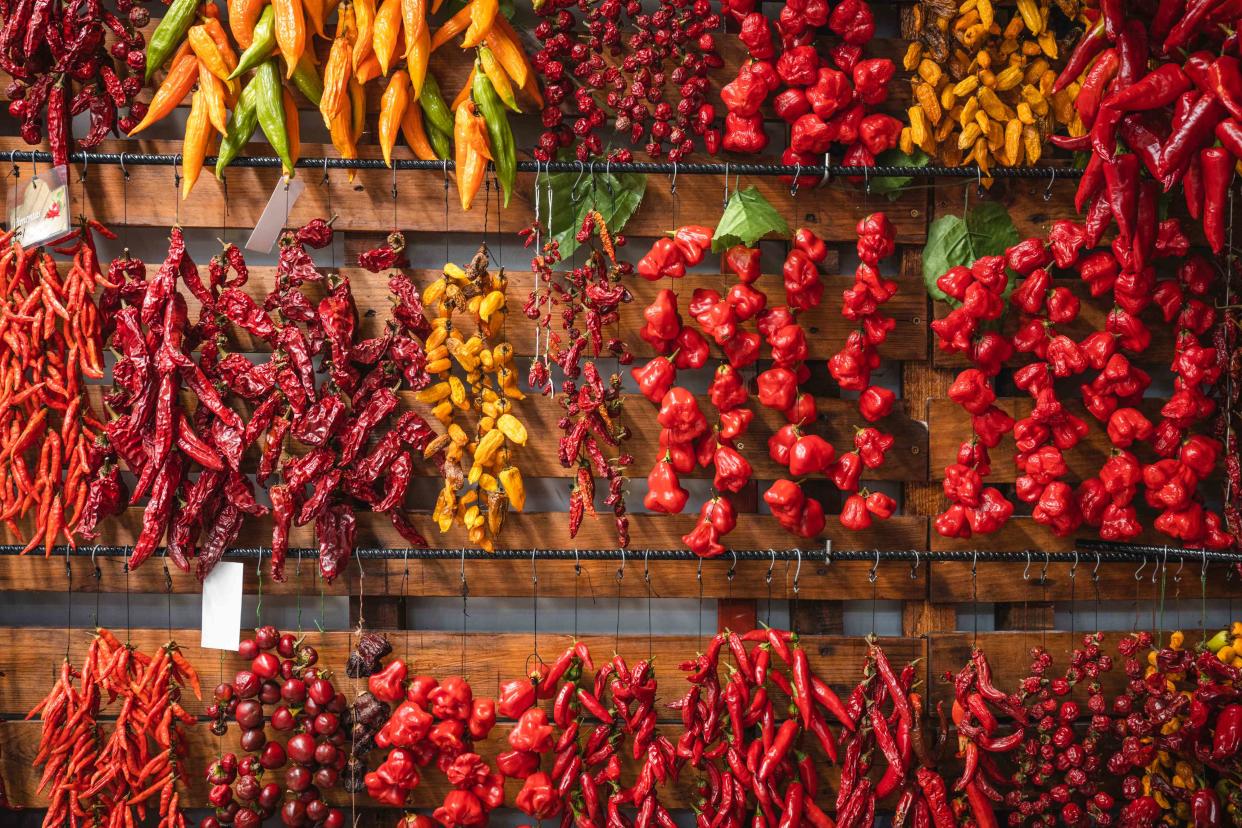How the Scoville Scale Works — and Where Your Favorite Chiles Fall
Here’s everything you need to know about the world’s most famous heat ranking system before you add chiles to your next meal.

Getty Images
You might’ve heard the Scoville scale used to describe some of the world’s hottest chile peppers, like Carolina Reaper and Pepper X, but even everyday cooking peppers like bell peppers and jalapeños can be measured in Scoville heat units. Here’s everything you should know about this heat ranking system.
What does the Scoville scale measure?
The Scoville scale is a measurement of pungency (aka spiciness) in members of the genus Capsicum, which includes peppers and chiles. It’s based on their levels of capsaicinoids like capsaicin, which are responsible for a burning sensation in the mouth and on the skin. The higher the perceived capsaicinoid levels, the higher the Scoville heat units (SHU).
How does the Scoville scale work?
Created by American pharmacist Wilbur Scoville in 1912, the Scoville scale involves preparing a solution with chile samples, then adding an increasing amount of a sugar-water mixture until professionally trained tasters can no longer detect any heat. Scoville heat units represent the amount of times the mixture has to be diluted until a burning sensation is no longer present. Mild bell peppers, for reference, have 0 Scoville heat units, while spicy Thai chiles can range from 50,000 to 100,000 units. The scale increases exponentially, so “mild hot” chile peppers will have twice the SHU of “mild” chiles, and so on.
Today, heat in chile peppers is often measured by a more objective test called high-performance liquid chromatography, which identifies the individual capsaicinoids in dried and ground chile peppers.
What is the hottest chile pepper in the world?
In 2023, the Guinness World Records recognized Pepper X as the hottest chile in the world. Bred by Ed Currie, a South Carolina hot pepper grower and owner of PuckerButt Pepper Company, it boasts an average heat level of 2.69 million Scoville heat units. The Pepper X beat the previous world record held by the Carolina Reaper, also grown by Currie, which has an average heat level of 1.57 million Scoville heat units. The Dragon’s Breath chile, though never tested by the Guinness World Records, is reported to have 2.48 million Scoville heat units.
How to use the Scoville scale
While it’s mostly used as a reference tool (and, as noted above, is not the most objective measure of heat), you may turn to the Scoville scale when you’re using chiles in a recipe. If you’re substituting jalapeños with serrano peppers, for example, you’ll want to keep in mind that the latter can have over twice the Scoville heat units of the former, and adjust the amount of chiles as needed.
Use the guide below to find out where your favorite chiles fall on the Scoville scale.
Scoville scale levels
Mild (0 to 2,000 SHU)
Bell pepper, Ancho poblano, Lombardo, Anaheim, Golden Greek pepperoncini
Mild Hot (2,000 to 50,000 SHU)
Jalapeño, cayenne, arbol, Fresno, serrano, tabasco, lemon drop
Hot (50,000+ SHU)
Thai peppers, chiltepin, Charleston, pequín, Rocoto
Spicy Hot (100,000+ SHU)
Scotch bonnet, Pimenta de Neyde, Jamaican yellow
Very Hot (250,000+ SHU)
Habanero, Fatalii yellow, Red Devil’s Tongue
Really Hot (500,000+ SHU)
7 Pot Yellow, 7 Pot Bubblegum, Red Savina
Fiery Hot (1 million+ SHU)
Ghost pepper/Bhut Jolokia, 7 Pot Lucy, Naga Viper, Komodo Dragon
Extreme Hot (1.5 million+ SHU)
Carolina Reaper, Trinidad Moruga Scorpion, 7 Pot Dougash
Heat level of common chile peppers in Scoville heat units (SHU)
Bell pepper: 0
Anaheim: 100 to 5,000
Jalapeño: 2,000 to 8,000
Fresno: 2,500 to 10,000
Serrano: 10,000 to 25,000
Chile de arbol: 15,000 to 30,000
Cayenne: 30,000 to 50,000
Thai chile peppers: 50,000 to 100,000
Habanero: 100,000 to 350,000
Scotch bonnet: 100,000 to 325,000
Ghost pepper: About 1 million
For more Food & Wine news, make sure to sign up for our newsletter!
Read the original article on Food & Wine.






